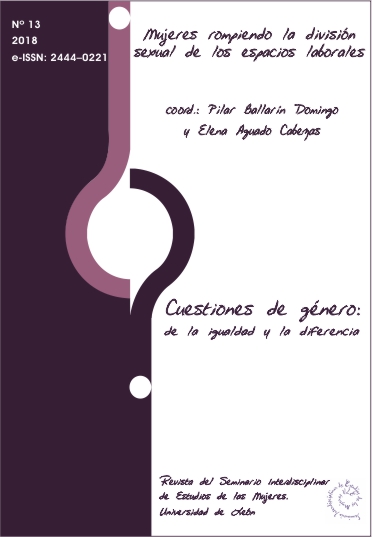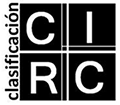The communication of authority in female versus male discourses: different errors, same result
DOI:
https://doi.org/10.18002/cg.v0i13.5102Keywords:
public speaking, nonverbal language, gender differences, authority, leaders, presentations, powerAbstract
The objective of this study is to determine whether women incur in more nonverbal communication errors than men when speaking to an audience. We draw our conclusions from a sample of future managers, as our subjects are students of master’s programs in business administration. We set out to prove the hypothesis that women make a wider involuntary use of gestures that detract from their transmission of authority. We conclude that this is not the case, proving our hypothesis wrong: both women and men incur in the same proportion of errors, albeit different, in communicating power through their nonverbal language.
Downloads
Métricas alternativas
References
Addington, David W. (1971): “The effect of vocal variations on ratings of source credibility”. En: Speech Monographs, vol. 38, nº. 3, pp. 242-247.
Akechi, Hironori; Senju, Atsushi; Uibo, Helen; Kikuchi, Yukiko; Hasegawa, Toshikazu, y Hietanen, Jari K. (2013): “Attention to eye contact in the West and East: autonomic responses and evaluative ratings”. En: PLOS ONE, vol. 8, nº. 3, pp. 1-10.
Anónimo (1954): Rhetorica ad Herennium. (Henry Caplan, trad.). Cambridge, MA: Harvard University Press.
Argyle, Michael (1988): Bodily communication. New York, NY: Routledge.
Argyle, Michael y Dean, Janet (1965): “Eye-contact, distance and affiliation”. En: Sociometry, vol. 28, nº. 3, pp. 289-304.
Avolio, Bruce J. y Bass, Bernard M. (1987): “Transformational leadership, charisma and beyond”. En James G. Hunt, B. Rajaram Baliga, H. Peter Dachler y Chester A. Schriesheim (eds.): Emerging leadership vistas. Boston: Lexington, pp. 29-50.
Atsuko, Aono (2003): “Gender differences in interpersonal distance: from the viewpoint of oppression hypothesis”. En: Japanese Journal of Experimental Social Psychology, vol. 42, pp. 201-218.
Bales, Robert F. (1950): Interaction process analysis: A method for the study of small groups. Reading, MA: Addison-Wesley.
Beebe, Steven A. (1976): Effects of eye contact, posture and vocal inflection upon credibility and comprehension. Miami, FL: University of Miami.
Benus, Stefan; Enos, Frank; Hirschberg, Julia y Shriberg, Elizabeth (2006): “Pauses in deceptive speech”. En: Speech Prosody, nº. 18, pp. 2-5.
Cicerón (1991): El orador. (Eustaquio Sánchez Salor, trad.). Madrid: Alianza Editorial.
Cicerón. (2013): Diálogos del orador. (Marcelino Menéndez Pelayo, trad.). Zaragoza: Servando Gotor.
Clark, Herbert H. y Fox Tree, Jean E. (2002): “Using uh and um in spontaneous speaking”. En: Cognition, vol. 84, pp. 73-111.
Davis, Flora (1989): La comunicación no verbal. Madrid: Alianza Editorial.
Du, Shichuan; Tao, Yong y Martínez, Aleix M. (2014): “Compound facial expressions of emotion”. En: Proceedings of the National Academy of Sciences of the United States of America, vol. 111, nº. 15, pp. 1454-1462.
Eagly, Alice H. (1987): Sex differences in social behavior: A social-role interpretation. Hillsdale, NJ: Erlbaum.
Eagly, Alice H. y Johnson, Blair T. (1990): “Gender and leadership style: A meta-analysis”. En: Psychological Bulletin, vol. 108, nº. 2, pp. 233-256.
Efron, David (1941): Gesto, raza y cultura. Buenos Aires: Ediciones Nueva Visión.
Ekman, Paul y Friesen, Wallace V. (1969): “The repertoire of nonverbal behavior: categories, origins, usage, and coding”. En: Semiotica, 1969, vol. 1, nº. 1, pp. 49-98.
Exline, Ralph V. (1963): “Explorations in the process of person perception: visual interaction in relation to competition, sex and need for affiliation”. En: Journal of Personality, vol. 31, nº. 1, pp. 1-20.
Farabee, David J.; Holcom, Melvin L.; Ramsey, Shawna L. y Cole, Steven G. (1993): “Social anxiety and speaker gaze in a persuasive atmosphere”. En: Journal of Research in Personality, nº. 27, pp. 365-376.
Friedman, Howard S.; Prince, Louise M.; Riggio, Ronald E. y DiMatteo, M. Robin (1980): “Understanding and assessing nonverbal expressiveness: the Affective Communication Test”. En: Journal of Personality and Social Psychology, vol. 39, nº. 2, pp. 333-351.
Gibbons, Pamela; Busch, Jon y Bradac, James J. (1991): “Powerful versus powerless language: consequences for persuasion, impression formation and cognitive response”. En: Language and Social Psychology, vol. 10, nº. 2, pp. 115-133.
Goldin-Meadow, Susan (1999): “The role of gesture in communication and thinking”. En: Trends in Cognitive Sciences, vol. 3, nº. 11, pp. 419-429.
Gullberg, Marianne (1998): “Gesture as a communication strategy in second language discourse: a study of learners of French and Swedish”. En: Travaux de l'institut de Linguistique de Lund, nº. 35, pp. 9-237.
Hall, Judith A. (1984): Nonverbal sex differences: Communication accuracy and expressive style. Baltimore, MD: Johns Hopkins University Press.
Hennig, Margaret y Jardim, Anne (1977): The managerial woman. New York, NY: Anchor Press.
Helminen, Terhi M; Kaasinen, Suvi M. y Hietanen, Jari K. (2011): “Eye contact and arousal: the effects of stimulus duration”. En: Biological Psychology, nº. 88, pp. 124-130.
Hernández Guerrero, José Antonio y García Tejera, María del Carmen (2004): El arte de hablar. Manual de retórica práctica y de oratoria moderna. Barcelona: Ariel.
Hosman, Lawrence A.; Huebner, Thomas M. y Siltanen, Susan A. (2002): “The impact of power-ofspeech style, argument strength, and need for cognition on impression formation, cognitive responses, and persuasion”. En: Journal of Language and Social Psychology, vol. 21, nº. 4, pp. 361-379.
Kendon, Adam. (2004): Gesture: visible action as utterance. Cambridge: Cambridge University Press.
Kimble, Charles E. y Musgrove, Jeffrey I. (1988): “Dominance in arguing mixed-sex dyads: visual dominance patterns, talking time, and speech loudness”. En: Journal of Research in Personality, nº. 22, pp. 1-16.
Kleinke, Chris L. (1986): “Gaze and eye contact: a research review”. En: Psychological Bulletin, vol. 100, nº. 1, pp. 78-100.
Knapp, Mark L. y Hall, Judith A. (2010): Nonverbal communication in human interaction. Boston, MA: Wadsworth.
Kowal, Sabine; O’Connell, Daniel C.; Forbush, Kathryn; Higgins, Mark; Clarke, Lindsay y D’Anna, Karey (1997): “Interplay of literacy and orality in inaugural rhetoric”. En: Journal of Psycholinguistic Research, vol. 26, nº. 1, pp. 1-31.
Loden, Marylin (1985): Feminine leadership or how to succeed in business without being one of the boys. New York, NY: Times Books.
Mansell, Warren; Clark, David M.; Ehlers, Anke y Chen, Yi Ping (1999): “Social anxiety and attention away from emotional faces”. En: Cognition and Emotion, vol. 13, nº. 6, pp. 673-690.
Mehrabian, Albert (1968): “Inference of attitudes form the posture, orientation and distance of a communicator”. En: Journal of Consulting and Clinical Psychology, vol. 32, nº. 3, pp. 296-308.
Mehrabian, Albert (1971): Silent messages: implicit communication of emotions and attitudes. Belmont, CA: Wadsworth.
Mehrabian, Albert (1972): Nonverbal communication. New Brunswick, NJ: Aldine Transaction.
Mehrabian, Albert y Ferris, Susan R. (1967): “Inference of attitudes from nonverbal communication in two channels”. En: Journal of Consulting Psychology, vol. 31, nº. 3, pp. 248-252.
Mehrabian, Albert y Wiener, Morton (1967): “Decoding of inconsistent communications”. En: Journal of Personality and Social Psychology, vol. 6, nº. 1, pp. 109-114.
Miller, Gerald R. y Hewgill, Murray A. (1964): “The effect of variations in nonfluency on audience ratings of source credibility”. En: Quarterly Journal of Speech, vol. 50, nº. 1, pp. 36-44.
O’Barr, William M. (1982): Linguistic evidence: language, power, and strategy in the courtroom. Cambridge, MA: Academic Press.
Rosenfeld, Howard M. (1966): “Instrumental affiliative functions of facial and gestural expressions”. En: Journal of Personal and Social Psychology, vol. 4, nº. 1, pp. 65-72.
Rosenthal, Robert; Hall, Judith A.; DiMatteo, M. Robin; Rogers, Peter L. y Archer, Dane (1979): Sensitivity to nonverbal communication: the PONS test. Baltimore, MD: Johns Hopkins University Press.
Scheflen, Albert E. (1984): Sistemas de comunicación humana. Barcelona: Kairós.
Wellen, A. Rodney (1987): “Heart-rate changes in response to shifts in interpersonal gaze from liked and disliked others”. En: Perceptual and motor skills, nº. 64, pp. 595-598.
Wheeler, R. Wade; Baron, Joan C.; Michell, Susan y Ginsburg, Harvey J. (1979): “Eye contact and the perception of intelligence”. En: Bulletin of the Psychonomic Society, vol. 13, nº. 2, pp. 101-102.
Wieser, Matthias J.; Pauli, Paul; Alpers, Georg W. y Mühlberger, Andreas (2009): “Is eye to eye contact really threatening and avoided in social anxiety? An eye-tracking and psychophysiology study”. En: Journal of Anxiety Disorders, nº. 23, pp. 93-103.
Downloads
Published
How to Cite
Issue
Section
License
Copyright (c) 2018 Javier Bernad Santa Olalla

This work is licensed under a Creative Commons Attribution-NonCommercial-ShareAlike 4.0 International License.
L@s autores/as que publican en esta revista están de acuerdo con los siguientes términos:
1. L@s autores/as ceden de forma no exclusiva los derechos de explotación (reproducción, distribución, comunicación pública, transformación) a la Universidad de León, por lo que pueden establecer, por separado, acuerdos adicionales para la distribución no exclusiva de la versión de la obra publicada en la revista (por ejemplo, alojarlo en un repositorio institucional o publicarlo en un libro), con un reconocimiento de su publicación inicial en esta revista.
2. Este trabajo se encuentra bajo la Creative Commons Attribution-NonCommercial-ShareAlike 4.0 International License. Puede consultarse desde aquí la versión informativa y el texto legal de la licencia.
3. Se permite y se anima a l@s autores/as a difundir electrónicamente las versiones pre-print (versión antes de ser evaluada) y/o post-print (versión evaluada y aceptada para su publicación) de sus obras antes de su publicación, ya que favorece su circulación y difusión más temprana y con ello un posible aumento en su citación y alcance entre la comunidad académica.
Cuestiones de Género utiliza exclusivamente la licencia Atribución-NoComercial-CompartirIgual 4.0 Internacional (CC BY- NC-SA 4.0).
Bajo los siguientes términos:
- Atribución: Usted debe dar crédito de manera adecuada , brindar un enlace a la licencia, e indicar si se han realizado cambios . Puede hacerlo en cualquier forma razonable, pero no de forma tal que sugiera que usted o su uso tienen el apoyo de la licenciante.
- No Comercial: Usted no puede hacer uso del material con propósitos comerciales .
- Compartir Igual: Si remezcla, transforma o crea a partir del material, debe distribuir su contribución bajo la la misma licencia del original. cualquier uso permitido por la licencia.
No hay restricciones adicionales — No puede aplicar términos legales ni medidas tecnológicas que restrinjan legalmente a otras a hacer
L@s autores/as pueden consultar los derechos de copyright y las condiciones de autoarchivo en el directorio Dulcinea.










